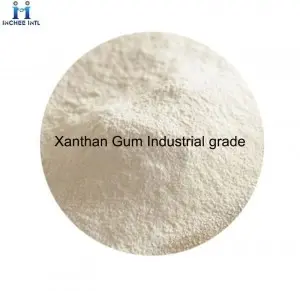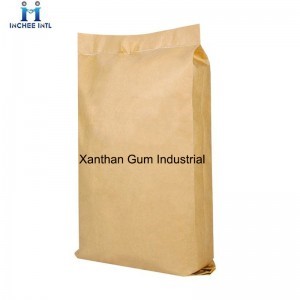Xanthan gum, also known as Hanseum gum, is a kind of microbial exopolysaccharide produced by Xanthomnas campestris by fermentation engineering using carbohydrates as the main raw material (such as corn starch). It has unique rheology, good water solubility, heat and acid-base stability, and has good compatibility with a variety of salts, as a thickening agent, suspension agent, emulsifier, stabilizer, can be widely used in food, petroleum, medicine and other more than 20 industries, is currently the world’s largest production scale and extremely widely used microbial polysaccharide.
Properties: Xanthan gum is light yellow to white movable powder, slightly smelly. Soluble in cold and hot water, neutral solution, resistant to freezing and thawing, insoluble in ethanol. Disperses with water and emulsifies into a stable hydrophilic viscous colloid.
Application:With its exceptional rheology, good water solubility, and exceptional stability under heat and acid-base conditions, xanthan gum has become an indispensable component in a wide range of applications. As a thickening agent, suspension agent, emulsifier, and stabilizer, it has found its way into more than 20 industries, including food, petroleum, medicine, and many others.
The food industry has been one of the primary beneficiaries of xanthan gum’s extraordinary capabilities. Its ability to enhance the texture and consistency of food products has made it a popular choice among manufacturers. Whether it’s in sauces, dressings, or bakery goods, xanthan gum ensures a smooth and appealing mouthfeel. Its compatibility with various salts further contributes to its versatility in food preparation.
In the petroleum industry, xanthan gum plays a crucial role in drilling and fracturing fluids. Its unique rheological properties make it an ideal additive, improving fluid viscosity and stability. Additionally, it acts as a filtration control agent, reducing the formation of filter cakes during the drilling process. Its ability to function under extreme temperature and pressure conditions has made it a favored choice among oilfield professionals.
The medical field also benefits greatly from the exceptional properties of xanthan gum. Its rheological behavior allows for controlled drug release, making it an ideal ingredient in pharmaceutical formulations. Furthermore, its biocompatibility and biodegradability make it suitable for various medical applications such as wound dressings and controlled drug delivery systems.
Beyond the aforementioned industries, xanthan gum finds its way into numerous other sectors, including the daily chemical industry. From toothpaste to shampoos, xanthan gum contributes to the desired texture and stability of these products.
The commercial viability of xanthan gum is unparalleled when compared to other microbial polysaccharides. Its wide range of applications and exceptional properties have made it a go-to ingredient for countless manufacturers. No other microbial polysaccharide can match its versatility and effectiveness.
Packing: 25kg/bag
Storage: Xanthan gum can be widely used in oil extraction, chemical, food, medicine, agriculture, dyes, ceramics, paper, textile, cosmetics, construction and explosive manufacturing and other more than 20 industries in about 100 kinds of products. In order to facilitate storage and transportation, it is generally made into dry products. Its drying has different treatment methods: vacuum drying, drum drying, spray drying, fluidized bed drying and air drying. Because it is a heat-sensitive substance, it cannot withstand high temperature treatment for a long time, so the use of spray drying will make it less soluble. Although the thermal efficiency of drum drying is high, the mechanical structure is more complex, and it is difficult to achieve for large-scale industrial production. Fluidized bed drying with inert spheres, due to both enhanced heat and mass transfer and grinding and crushing functions, the material retention time is also short, so it is suitable for drying heat-sensitive viscous materials like xanthan gum.
1. When preparing xanthan gum solution, if the dispersion is insufficient, clots will appear. In addition to fully stirring, it can be pre-mixed with other raw materials, and then added to the water while stirring. If it is still difficult to disperse, a miscible solvent with water can be added, such as a small amount of ethanol.
2. Xanthan gum is an anionic polysaccharide, which can be used together with other anionic or non-ionic substances, but cannot be compatible with cationic substances. Its solution has excellent compatibility and stability to most salts. Adding electrolytes such as sodium chloride and potassium chloride can improve its viscosity and stability. Calcium, magnesium and other bivalent salts showed similar effects on their viscosity. When the salt concentration is higher than 0.1%, the optimal viscosity is reached. Too high salt concentration does not improve the stability of xanthan gum solution, nor does it affect its rheology, only pH> At 10 o ‘clock (food products rarely appear), the bivalent metal salts show a tendency to form gels. Under acidic or neutral conditions, its trivalent metal salts such as aluminum or iron form gels. The high content of monovalent metal salts prevents gelation.
3. Xanthan gum can be combined with most commercial thickeners, such as cellulose derivatives, starch, pectin, dextrin, alginate, carrageenan, etc. When combined with galactomannan, it has a synergistic effect on increasing viscosity.
In conclusion, xanthan gum is a true marvel of modern science. Its unique capabilities as a thickening agent, suspension agent, emulsifier, and stabilizer have revolutionized the way various industries function. From the food we consume to the medicines we rely on, xanthan gum’s impact is undeniable. Its commercial popularity and broad application make it a true powerhouse in the world of ingredients. Embrace the magic of xanthan gum and unlock its potential in your products today.
Post time: Jul-03-2023








